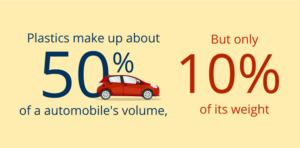The automobile industry is using more and more plastic material. Plastic components can be manufactured using a variety of techniques, depending on the specifications. Nonetheless, it appears that the most often used procedure is injection moulding.

Let’s attempt to comprehend the types of flaws that are found in injection-molded components. The following flaws could be present in components made through the injection moulding process.
Tearing of the component during ejection.
Cracking of components during ejection or solidification.
Local shrinkage (cavity formation on surfaces).
Underfilling of the component.
Loss of stiffness at some zones.
Tearing of components at corners
Non-uniform solidification results in variations in strength at different zones.
Production engineers employ a variety of techniques to reduce these flaws, such as monitoring the proper temperature and viscosity of molten plastics, regulating injection time, and so forth. Our discussion centers on using design parameters to control these defects, though.
Introduction of “Draft”
Because plastic components are so thin, they are delicate. Surfaces of components that run parallel to the direction of component ejection and mould separation are more likely to tear off. This results from the component surface rubbing against each other at the cavity mould separation (1) and the core mould during the component’s ejection (2) from the core.
The Draft angle at these spots must be between one and three inches. This draft facilitates the part’s easy, non-rubbing release from the mould.
Introduction of Appropriate “Corner Radius”
A corner that is extremely sharp is more likely to tear. Furthermore, corner cooling is proportionately faster and produces a greater tendency for cracking because of the proportionately larger surrounding area for cooling. Rather, a relatively blunt and smooth radius at the corner facilitates easy propagation of molten plastic during mould filling, easy separation from moulds, and relatively steady solidification.
As a result, a corner radius of at least one to two times the component thickness is necessary. Even bigger corner radii, like 10 and 15 mm, are preferred, but they cause a significant alteration to the component’s shape. These corner radii are also referred to as fillets, and occasionally they are “3-D” features.
Avoiding Non-uniform Thickness at Junctions
Wall functions that exhibit varying wall thicknesses experience uneven solidification and cooling. Greater wall thickness causes solidification to proceed more slowly, whereas smaller wall thickness causes it to happen more quickly. As such, sites such as (1) are more likely to fracture, and cations such as (2) are more likely to experience local shrinkage and blind cavity formation. On the other hand, local shrinkage and cracking are prevented if the wall thicknesses at the junctions remain constant.
Avoiding Abrupt Changes in the Wall Thickness
A change in wall thickness like that shown in (A) increases the risk of local shrinkage or cracks. Basically, you should stay away from them as much as possible. If they cannot be avoided, though, they must be changed to produce a gradual change similar to B.
While there will be some difficulties with the modification “B,” they will be less than with A.
Avoiding too small thickness for a longer zone
It is not necessary to force molten plastic to pass through a narrow passage component thickness over a significant distance. In these situations, the leading plastic might have trouble solidifying before the molten plastic gets to its intended location. Therefore, a zone for plastic propagation should never be longer than 1 mm for thinner thicknesses. The longer zones can fit in if the thickness is closer to 2-4 mm.
Provision of Ribs
Sometimes the plastic wall thickness that is undergoing a 90° rotation is not strong enough to support the loads. It is possible to supply the ribs with the proper base and height. It is anticipated that the thickness at each rib will match the thickness of the parent wall. Normally, the ribs are shaped like a triangle. They may even be concave, though, if one is likely to cause fouling during the assembly.
Provision of Embossing
Ribs cannot be allowed on large, plain surfaces if there is no orientation change. The strength and stiffness of the object can be increased in these situations by using embossing. Embossing can take the shape of an emblem or the manufacturer’s logo, or it can have a decorative appearance.
Recruiter’s expectations are moving up
As a recent graduate of mechanical engineering, you are aware that you will be applying for jobs at companies in a variety of industries, including plastics, heavy machinery, automotive, and aviation. It makes sense that businesses in the plastics industry would seek out engineering graduates who have a rudimentary understanding of the design considerations and manufacturing processes involved in producing plastic components.
A few years ago, job-based learning was the primary method of learning about the plastic manufacturing industry. Engineers were trained for their jobs before they started working there. But these days, hiring companies have higher standards. They are looking for some basic understanding of plastic component design and manufacturing processes, even at the entry level. A course like G2G INNOVATION Product and Tool Design Engineer can help you get ready for these higher standards.
If you understand the fundamentals of plastic manufacturing, engineering drawings, tolerances, and GD&T will be additional tools in your toolbox. And doing this will undoubtedly help you stand out from the competition during the hiring process.

